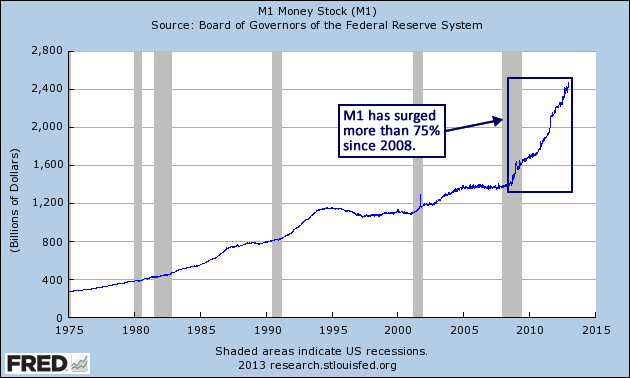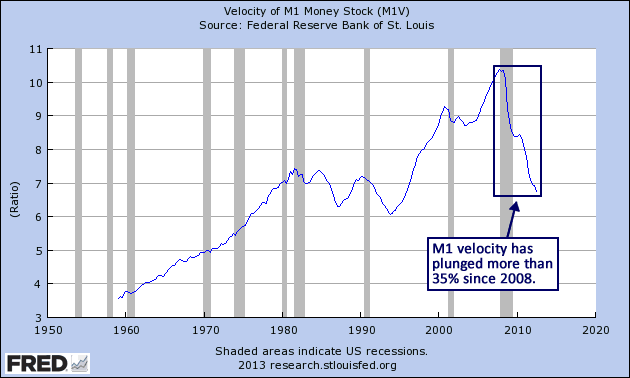Following the financial crisis in 2008, the US Federal Reserve engaged in an historic liquidity operation intended to support economic recovery that continues today. Since the recession in 2008, M1 money supply has surged an astonishing 75 percent, topping the $2.4 trillion level in December with no end in sight to the extreme move higher.
However, during that time, the velocity of M1 money has plunged from a high of 10.37 in late 2007 to less than 7 in late 2012.
Essentially, velocity measures how fast money changes hands, providing a gauge of economic activity. In basic terms, when velocity declines sharply even as supply is being introduced at an unprecedented rate, the implication is that the added liquidity is not engendering economic activity. This is what “pushing on a string” looks like. As economist Paul Samuelson once observed:
You can lead a horse to water, but you cannot make him drink. You can force money into the system in exchange for government bonds, its close money substitute; but you cannot make the money circulate against new goods and services.
Consequently, the M1 money multiplier has remained below the 1.0 level during the last four years.
Again, the Federal Reserve can attempt to spur economic activity by introducing monetary stimuli, but it cannot force banks to increase their loan and investment activity. The velocity and multiplier data trends clearly demonstrate that the newly introduced M1 supply is simply remaining idle in places like bank reserves.
Federal Reserve Chairman Bernanke understands the dilemma, but he would prefer to deal with any problem except deflation, so he has committed to flooding the system with liquidity for the foreseeable future and worrying about the consequences later. In fact, he has even admitted that his intention is to inflate risky asset prices.
Recall that when the second quantitative easing program was introduced in late 2010, Bernanke stated in no uncertain terms that one of the primary goals of the program was to inflate the stock market. The following quote is from an article written by Bernanke and published in the Washington Post in November 2010:
Stock prices rose and long-term interest rates fell when investors began to anticipate the most recent action. Easier financial conditions will promote economic growth. … And higher stock prices will boost consumer wealth and help increase confidence, which can also spur spending. Increased spending will lead to higher incomes and profits that, in a virtuous circle, will further support economic expansion.
There is no question that the measures taken by the Federal Reserve during the last three years have fueled appreciation in the stock market, so, from that perspective, the programs have been a success. However, it must be noted that equity gains fueled primarily by government stimuli can be erased as quickly as they are created. The liquidity operations that have produced the huge spike in M1 since 2008 have created massive structural imbalances that will continue to drive violent moves both higher and lower as the system attempts to return to a state of equilibrium.
Additionally, there is absolutely no evidence to support the assertion that higher stock prices meaningfully support economic expansion. Historically, a 1.0 percent increase in the S&P 500 index has been accompanied by GDP growth of approximately 0.04 percent during the same year, 0.04 percent growth during the next year, and it has a negative correlation during subsequent years. However, for better or for worse, the Federal Reserve remains locked into this course of action for the foreseeable future. Chairman Bernanke believes he has the tools and expertise required to prevent these unprecedented structural imbalances from engendering massive economic disruptions when they are purged from the system sometime during the next several years. Seeing as no central bank in history has been able to accomplish that feat, it is highly likely that he will be unable to do so as well.
- English (UK)
- English (India)
- English (Canada)
- English (Australia)
- English (South Africa)
- English (Philippines)
- English (Nigeria)
- Deutsch
- Español (España)
- Español (México)
- Français
- Italiano
- Nederlands
- Português (Portugal)
- Polski
- Português (Brasil)
- Русский
- Türkçe
- العربية
- Ελληνικά
- Svenska
- Suomi
- עברית
- 日本語
- 한국어
- 简体中文
- 繁體中文
- Bahasa Indonesia
- Bahasa Melayu
- ไทย
- Tiếng Việt
- हिंदी
Monetary Velocity Continues To Decline
Published 01/10/2013, 12:11 AM
Updated 07/09/2023, 06:31 AM
Monetary Velocity Continues To Decline
3rd party Ad. Not an offer or recommendation by Investing.com. See disclosure here or
remove ads
.
Latest comments
Install Our App
Risk Disclosure: Trading in financial instruments and/or cryptocurrencies involves high risks including the risk of losing some, or all, of your investment amount, and may not be suitable for all investors. Prices of cryptocurrencies are extremely volatile and may be affected by external factors such as financial, regulatory or political events. Trading on margin increases the financial risks.
Before deciding to trade in financial instrument or cryptocurrencies you should be fully informed of the risks and costs associated with trading the financial markets, carefully consider your investment objectives, level of experience, and risk appetite, and seek professional advice where needed.
Fusion Media would like to remind you that the data contained in this website is not necessarily real-time nor accurate. The data and prices on the website are not necessarily provided by any market or exchange, but may be provided by market makers, and so prices may not be accurate and may differ from the actual price at any given market, meaning prices are indicative and not appropriate for trading purposes. Fusion Media and any provider of the data contained in this website will not accept liability for any loss or damage as a result of your trading, or your reliance on the information contained within this website.
It is prohibited to use, store, reproduce, display, modify, transmit or distribute the data contained in this website without the explicit prior written permission of Fusion Media and/or the data provider. All intellectual property rights are reserved by the providers and/or the exchange providing the data contained in this website.
Fusion Media may be compensated by the advertisers that appear on the website, based on your interaction with the advertisements or advertisers.
Before deciding to trade in financial instrument or cryptocurrencies you should be fully informed of the risks and costs associated with trading the financial markets, carefully consider your investment objectives, level of experience, and risk appetite, and seek professional advice where needed.
Fusion Media would like to remind you that the data contained in this website is not necessarily real-time nor accurate. The data and prices on the website are not necessarily provided by any market or exchange, but may be provided by market makers, and so prices may not be accurate and may differ from the actual price at any given market, meaning prices are indicative and not appropriate for trading purposes. Fusion Media and any provider of the data contained in this website will not accept liability for any loss or damage as a result of your trading, or your reliance on the information contained within this website.
It is prohibited to use, store, reproduce, display, modify, transmit or distribute the data contained in this website without the explicit prior written permission of Fusion Media and/or the data provider. All intellectual property rights are reserved by the providers and/or the exchange providing the data contained in this website.
Fusion Media may be compensated by the advertisers that appear on the website, based on your interaction with the advertisements or advertisers.
© 2007-2024 - Fusion Media Limited. All Rights Reserved.
